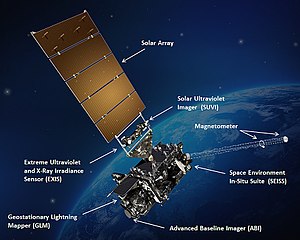
Back قمر أرصاد جوية Arabic Satèl·lit meteorològic Catalan Meteorologická družice Czech Vejrsatellit Danish Wettersatellit German Μετεωρολογικός δορυφόρος Greek Vetersatelito Esperanto Satélite meteorológico Spanish Satelite meteorologiko Basque ماهواره هواشناسی Persian

A weather satellite or meteorological satellite is a type of Earth observation satellite that is primarily used to monitor the weather and climate of the Earth. Satellites are mainly of two types: polar orbiting (covering the entire Earth asynchronously) or geostationary (hovering over the same spot on the equator).[1]
While primarily used to detect the development and movement of storm systems and other cloud patterns, meteorological satellites can also detect other phenomena such as city lights, fires, effects of pollution, auroras, sand and dust storms, snow cover, ice mapping, boundaries of ocean currents, and energy flows. Other types of environmental information are collected using weather satellites. Weather satellite images helped in monitoring the volcanic ash cloud from Mount St. Helens and activity from other volcanoes such as Mount Etna.[2] Smoke from fires in the western United States such as Colorado and Utah have also been monitored.
El Niño and its effects on weather are monitored daily from satellite images. The Antarctic ozone hole is mapped from weather satellite data. Collectively, weather satellites flown by the U.S., Europe, India, China, Russia, and Japan provide nearly continuous observations for a global weather watch.
- ^ NESDIS. Satellites.[link not working] Retrieved on July 4, 2008. Archived July 4, 2008, at the Wayback Machine
- ^ NOAA. NOAA Satellites, Scientists Monitor Mt. St. Helens for Possible Eruption. Archived September 10, 2012, at archive.today Retrieved on July 4, 2008.